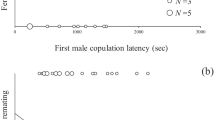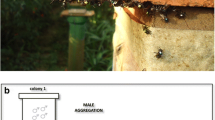Abstract
Polyandry creates the opportunity for post-mating sexual selection, and pre- and post-mating sexual selection affects male traits. Investigation of selection pressures in both pre- and post-mating stages is necessary to understand sexual selection. In the cigarette beetle Lasioderma serricorne, we found previously that males that mated faster are thought to be more attractive in the pre-mating process. However, whether the attractive males are favored by the post-mating process remains unclear and thus we set out to investigate this. The attractive males (judged by the pre-mating process) were able to mate sooner with both virgin and non-virgin females. However, attractive males invested less in ejaculation and have difficulty keeping mated females from remating with other males. Thus, under the polyandrous condition, attractive males have a disadvantage in reproductive success due to the risk of sperm competition because they cannot prevent female remating. Therefore, whether a female remates or not would be an important factor in the reproductive success of an attractive male. On the other hand, when a female mated with two males, the last male always sires more offspring, and males who were attractive in pre-mating process did not sire more offspring. These findings suggest that attractive males are at least not favored by the post-mating process itself, and the association between pre- and post-mating sexual selection in L. serricorne is not as simple as reinforcing or undermining.
Significance statement
Because females generally mate with multiple males, sexual selection occurs not only before copulation but also after. Thus, investigating the interplay between pre- and post-mating sexual selections is needed to understand sexual selection, but it is still relatively understudied. In the cigarette beetle, males that courted females more were favored by pre-mating processes. Such attractive males had more success mating with virgin and non-virgin females. However, females that have mated with attractive males readily remate with other males, suggesting that the attractive males cannot prevent sperm competition. Thus, the reproductive success of attractive males may be lower under the higher frequency of female remating. Furthermore, non-virgin females were unlikely to bias paternity toward attractive males. These results suggest that males that are favored by pre-mating processes are not favored by post-mating processes in this beetle.





Similar content being viewed by others
References
Abraham S, Goane L, Cladera J, Vera MT (2011) Effects of male nutrition on sperm storage and remating behavior in wild and laboratory Anastrepha fraterculus (Diptera: Tephritidae) females. J Insect Physiol 57:1501–1509. doi:10.1016/j.jinsphys.2011.08.004
Arnqvist G, Nilsson T (2000) The evolution of polyandry: multiple mating and female fitness in insects. Anim Behav 60:145–164. doi:10.1006/anbe.2000.1446
Andersson M (1994) Sexual selection. Princeton University Press, Princeton
Andersson MB, Simmons LW (2006) Sexual selection and mate choice. Trends Ecol Evol 21:296–302. doi:10.1016/j.tree.2006.03.015
Arnqvist G, Rowe L (2005) Sexual conflict. Princeton University Press, Princeton
Ashworth JR (1993) The biology of Lasioderma serricorne. J Stored Prod Res 29:291–303. doi:10.1016/0022-474X(93)90044-5
Avila FW, Sirot LK, LaFlamme BA, Rubinstein CD, Wolfner MF (2011) Insect seminal fluid proteins: identification and function. Annu Rev Entomol 56:21–40. doi:10.1146/annurev-ento-120709-144823
Birkhead TR, Møller AP (1998) Sperm competition and sexual selection. Academic Press, New York
Charlesworth D, Charlesworth B (1987) Inbreeding depression and its evolutionary consequences. Annu Rev Ecol Syst 18:237–268
Coffelt JA (1975) Multiple mating by Lasioderma serricorne (F.) - Effects on fertility and fecundity. Proceedings of the First International Working Conference on Stored Product Entomology. Savannah, Georgia, p 549–553
Crawley MJ (1993) GLIM for ecologists. Blackwell Scientific, Oxford
Danielsson I (2001) Antagonistic pre–and post–copulatory sexual selection on male body size in a water strider (Gerris lacustris). Proc R Soc Lond B 268:77–81. doi:10.1098/rspb.2000.1332
Dougherty LR, Simmons LW, Shuker DM (2016) Postcopulatory sexual selection when a female mates once. Anim Behav 116:13–16. doi:10.1016/j.anbehav.2016.03.003
Droge-Young EM, Manier MK, Lüpold S, Belote JM, Pitnick S (2012) Covariance among premating, post-copulatory and viability fitness components in Drosophila melanogaster and their influence on paternity measurement. J Evol Biol 25:1555–1563. doi:10.1111/j.1420-9101.2012.02540.x
Eberhard WG (1996) Female control: sexual selection by cryptic female choice. Princeton University Press, Princeton
Engqvist L (2011) Male attractiveness is negatively genetically associated with investment in copulations. Behav Ecol 22:345–349. doi:10.1093/beheco/arq211
Evans JP, Zane L, Francescato S, Pilastro A (2003) Directional postcopulatory sexual selection revealed by artificial insemination. Nature 421:360–363. doi:10.1038/nature01367
Falconer DS, Mackay TFC (1996) Introduction to quantitative genetics, 4th edn. Longman, New York
Friberg U, Arnqvist G (2003) Fitness effects of female mate choice: preferred males are detrimental for Drosophila melanogaster females. J Evol Biol 16:797–811. doi:10.1046/j.1420-9101.2003.00597.x
Gillott C (2003) Male accessory gland secretions: modulators of female reproductive physiology and behavior. Annu Rev Entomol 48:163–184. doi:10.1146/annurev.ento.48.091801.112657
Grafen A, Hails R (2002) Modern statistics for the life sciences. Oxford University Press, Oxford
Harano T (2015) Receptive females mitigate costs of sexual conflict. J Evol Biol 28:320–327. doi:10.1111/jeb.12563
Harano T, Miyatake T (2007) Interpopulation variation in female remating is attributable to female and male effects in Callosobruchus chinensis. J Ethol 25:49–55. doi:10.1007/s10164-006-0204-8
Halstead DGH (1963) External sex differences in stored product Coleoptera. Bull Entomol Res 54:119–134
Hosken DJ, Garner TWJ, Tregenza T, Wedell N, Ward PI (2003) Superior sperm competitors sire higher–quality young. Proc R Soc Lond B 270:1933–1938. doi:10.1098/rspb.2003.2443
Hosken DJ, Taylor ML, Hoyle K, Higgins S, Wedell N (2008) Attractive males have greater success in sperm competition. Curr Biol 18:R553–R554. doi:10.1016/j.cub.2008.04.028
Hunt J, Breuker CJ, Sadowski JA, Moore AJ (2009) Male–male competition, female mate choice and their interaction: determining total sexual selection. J Evol Biol 22:13–26. doi:10.1111/j.1420-9101.2008.01633.x
Jennions MD, Petrie M (2000) Why do females mate multiply? A review of the genetic benefits. Biol Rev 75:21–64. doi:10.1111/j.1469-185X.1999.tb00040.x
Jennions MD, Backwell PRY, Passmore NI (1995) Repeatability of mate choice: the effect of size in the African painted reed frog, Hyperolius marmoratus. Anim Behav 49:181–186. doi:10.1016/0003-3472(95)80165-0
Katsuki M, Lewis Z (2015) A trade-off between pre-and post-copulatory sexual selection in a bean beetle. Behav Ecol Sociobiol 69:1597–1602. doi:10.1007/s00265-015-1971-4
Kotiaho JS (2002) Sexual selection and condition dependence of courtship display in three species of horned dung beetles. Behav Ecol 13:791–799. doi:10.1093/beheco/13.6.791
Kotiaho JS, Simmons LW, Tomkins JL (2001) Towards a resolution of the lek paradox. Nature 410:684–686. doi:10.1038/35070557
Kvarnemo C, Simmons LW (2013) Polyandry as a mediator of sexual selection before and after mating. Philos Trans R Soc B 368:20120042. doi:10.1098/rstb.2012.0042
Lewis SM, Austad SN (1994) Sexual selection in flour beetles: the relationship between sperm precedence and male olfactory attractiveness. Behav Ecol 5:223–224. doi:10.1093/beheco/5.2.223
Lewis Z, Lizé A, Wedell N (2013) The interplay between different stages of reproduction in males of the moth Plodia interpunctella. Anim Behav 86:917–922. doi:10.1016/j.anbehav.2013.08.006
Malo AF, Roldan ER, Garde J, Soler AJ, Gomendio M (2005) Antlers honestly advertise sperm production and quality. Proc R Soc Lond B 272:149–157. doi:10.1098/rspb.2004.2933
Neems RM, Lazarus J, Mcadllan AJ (1998) Lifetime reproductive success in a swarming midge: trade-offs and stabilizing selection for male body size. Behav Ecol 9:279–286. doi:10.1093/beheco/9.3.279
Okada K, Katsuki M, Sharma MD, House CM, Hosken DJ (2014) Sexual conflict over mating in Gnatocerus cornutus? Females prefer lovers not fighters. Proc R Soc Lond B 281:20140281. doi:10.1098/rspb.2014.0281
Okada K, Archer CR, Katsuki M, Suzaki Y, Sharma MD, House CM, Hosken DJ (2015) Polyandry and fitness in female horned flour beetles, Gnatocerus cornutus. Anim Behav 106:11–16. doi:10.1016/j.anbehav.2015.05.008
Okada K, Fuchikawa T, Omae Y, Katsuki M (2013) Pre-copulatory sexual selection in the cigarette beetle Lasioderma serricorne. Behal Ecol Sociobiol 67:53–59. doi:10.1007/s00265-012-1424-2
Omae Y, Fuchikawa T, Nakayama S, Okada K, Miyatake T, Sasaki R, Shinoda K (2012) Life history and mating behavior of a black-bodied strain of the cigarette beetle Lasioderma serricorne (Coleoptera: Anobiidae). Appl Entomol Zool 47:157–163. doi:10.1007/s13355-012-0103-0
Panova M, Boström J, Hofving T, Areskoug T, Eriksson A, Mehlig B et al (2010) Extreme female promiscuity in a non-social invertebrate species. PLoS One 5:e9640. doi:10.1371/journal.pone.0009640
Parker GA (1979) Sexual selection and sexual conflict. In: Blum MS, Blum NA (eds) Sexual selection and reproductive competition in insects. Academic, London, pp. 123–166
Partridge L, Fowler K (1990) Non-mating costs of exposure to males in female Drosophila melanogaster. J Insect Physiol 36:419–425. doi:10.1016/0022-1910(90)90059-O
Pischedda A, Rice WR (2012) Partitioning sexual selection into its mating success and fertilization success components. Proc Natl Acad Sci U S A 109:2049–2053. doi:10.1073/pnas.1110841109
Qazi MCB, Herbeck JT, Lewis SM (1996) Mechanisms of sperm transfer and storage in the red flour beetle (Coleoptera: Tenebrionidae). Ann Entomol Soc Am 89:892–897. doi:10.1093/aesa/89.6.892
SAS Institute (2013) JMP release 11.0. SAS Institute Inc, Cary
Savalli UM, Fox CW (1999) The effect of male mating history on paternal investment, fecundity and female remating in the seed beetle Callosobruchus maculatus. Funct Ecol 13:169–177. doi:10.1046/j.1365-2435.1999.00287.x
Simmons LW (2001) Sperm competition and its evolutionary consequences in the insects. Princeton University Press, Princeton
Simmons LW, Emlen DJ (2006) Evolutionary trade-off between weapons and testes. Proc Natl Acad Sci U S A 103:16346–16351. doi:10.1073/pnas.0603474103
South A, Lewis SM (2012) Determinants of reproductive success across sequential episodes of sexual selection in a firefly. Proc R Soc Lond B 279:3201–3208. doi:10.1098/rspb.2012.0370
Thornhill R, Alcock J (1983) The evolution of insect mating systems. Harvard University Press, Cambridge
Tomkins JL, Radwan J, Kotiaho JS, Tregenza T (2004) Genic capture and resolving the lek paradox. Trends Ecol Evol 19:323–328. doi:10.1016/j.tree.2004.03.029
Watson PJ (1991) Multiple paternity as genetic bet-hedging in female sierra dome spiders, Linyphia litigiosa (Linyphiidae). Anim Behav 41:343–360. doi:10.1016/S0003-3472(05)80486-5
Wedell N (2005) Female receptivity in butterflies and moths. J Exp Biol 208:3433–3440
Yamane T, Kimura Y, Katsuhara M, Miyatake T (2008) Female mating receptivity inhibited by injection of male-derived extracts in Callosobruchus chinensis. J Insect Physiol 54:501–507. doi:10.1016/j.jinsphys.2007.11.009
Yamane T, Miyatake T (2008) Strategic ejaculation and level of polyandry in Callosobruchus chinensis (Coleoptera: Bruchidae). J Ethol 26:225–231. doi:10.1007/s10164-007-0051-2
Yamane T, Okada K, Nakayama S, Miyatake T (2010) Dispersal and ejaculate strategies associated with exaggeration of weapon in an armed beetle. Proc R Soc B 77:1705–1710 . doi:10.1098/rspb.2009.2017rspb20092017
Acknowledgements
This work was supported by the Japan Society for the Promotion of Science (Grants-in-Aid for JSPS Fellows 251662).
Author information
Authors and Affiliations
Corresponding author
Additional information
Communicated by N. Wedell
Rights and permissions
About this article
Cite this article
Katsuki, M., Fujiwara, H., Kodera, S. et al. Relationships between male attractiveness, female remating, and sperm competition in the cigarette beetle. Behav Ecol Sociobiol 71, 21 (2017). https://doi.org/10.1007/s00265-016-2229-5
Received:
Revised:
Accepted:
Published:
DOI: https://doi.org/10.1007/s00265-016-2229-5




